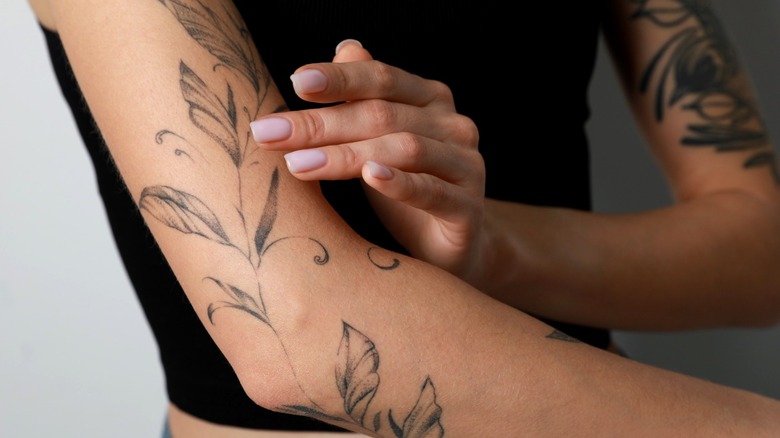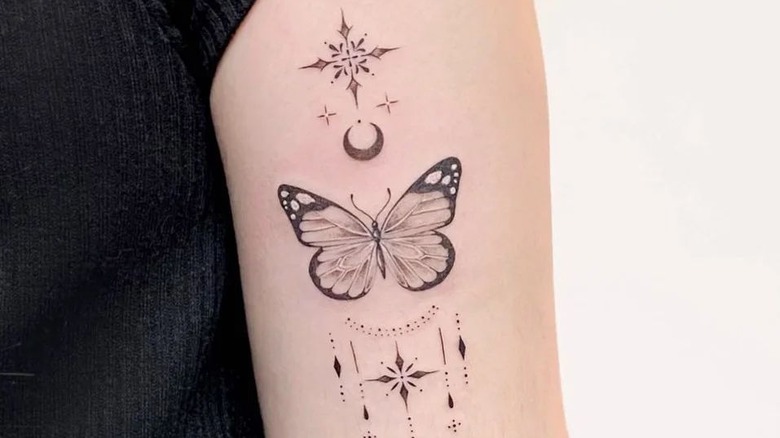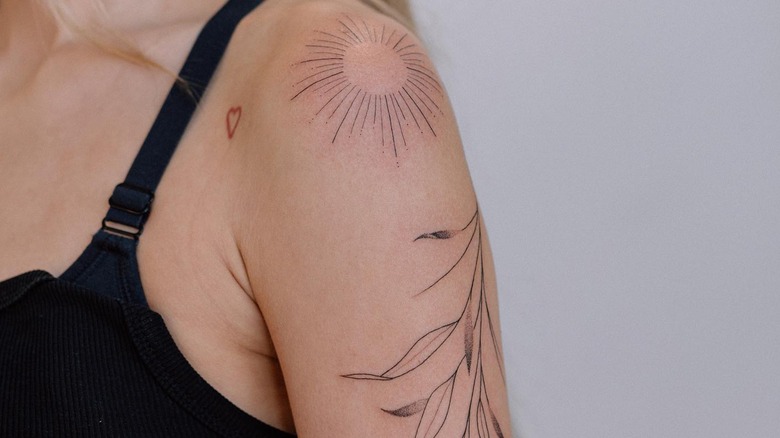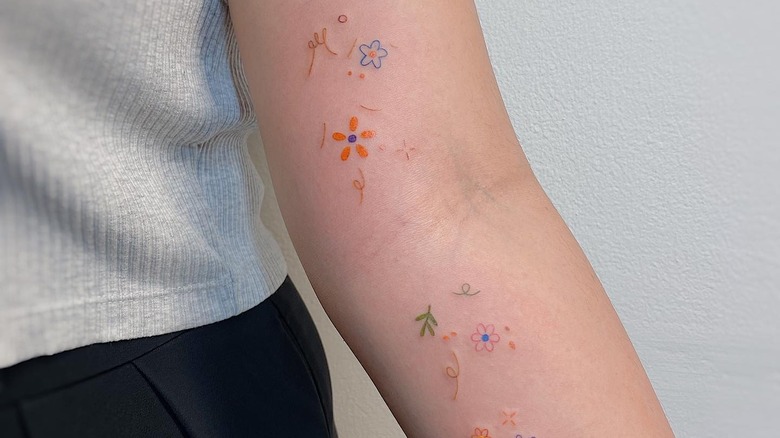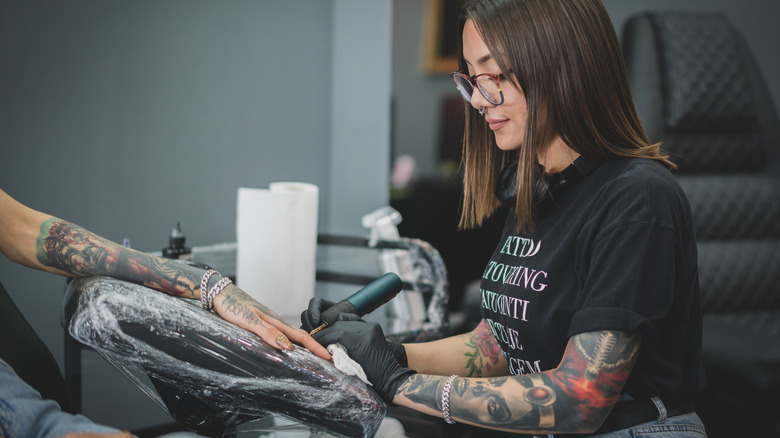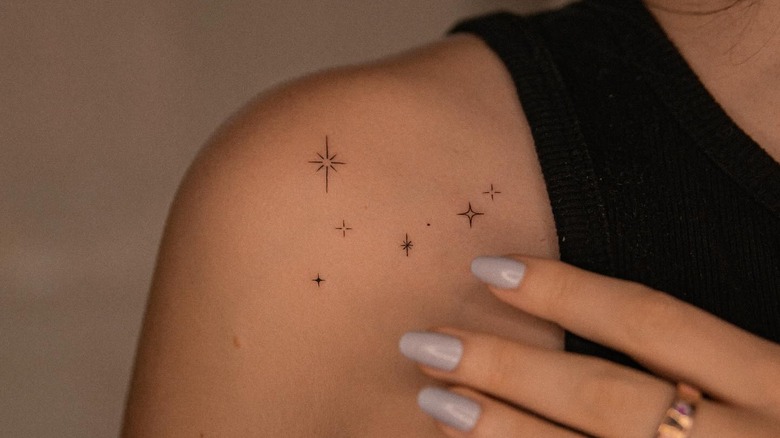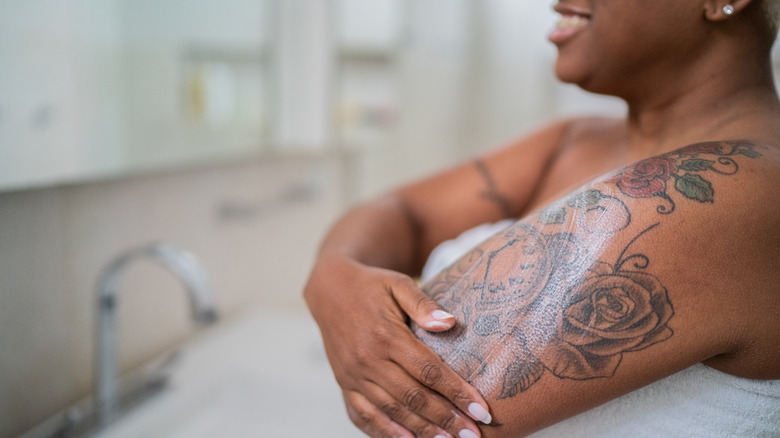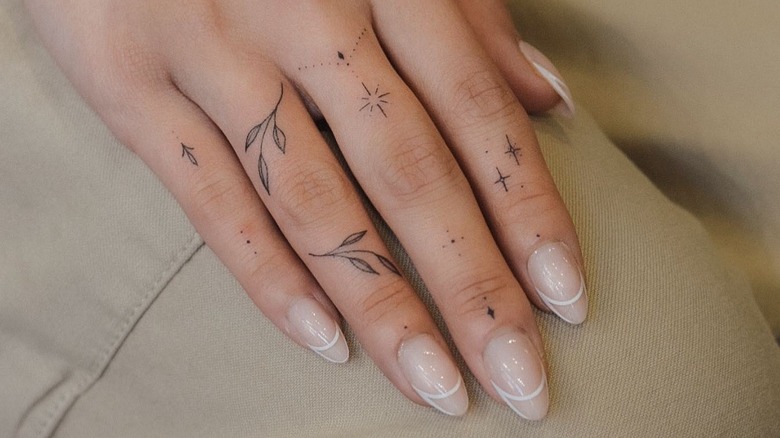Fine Line Tattoos: What You Should Know
When it comes to tattoos, there are many celebrated styles, from intricate Japanese designs and vibrant over-the-top new-school pieces to the classic and straightforward vibe of American traditional. But in an industry driven by artists, there are always creative and cutting-edge ways to embrace self-expression. Right now, one of the most popular styles is a relative newcomer: the ethereal aesthetic of fine-line tattoos.
Even if you don't recognize this style by name, you may have seen examples of fine-line tattooing on some of your favorite celebrities. For instance, Sophie Turner of "Game of Thrones" fame has several dainty designs on her skin, including a barely-there tattoo of the north star along her spine, which was inked by renowned Hollywood tattoo artist Winter Stone (via Instagram).
Fine-line tattooing has also taken social media by storm, with plenty of gorgeous examples populating your Insta feed or ready to fill up a new Pinterest board. But what makes fine-line tattooing so distinct from other styles, and what should you know before getting one yourself?
What are fine-line tattoos?
At their core, fine-line tattoos are exactly what they sound like — extremely delicate designs created with thin linework. Typically done in black ink using a highly precise needle, these pieces avoid the bold outlines or gradation seen in most other styles. The result is a sleek and elegant look that resembles an ink drawing done on paper.
Because they tend to be small and understated, fine-line tattoos have become closely associated with the concept of minimalism. While there's nothing to say that a proclaimed minimalist couldn't get an expansive and colorful back piece, fine-line tattoos often fit the minimalist idea that less is more. This may be because fine-line tattooing is usually used for graceful script, dreamy, sketch-like outlines, or the application of a tiny micro-tattoo.
As the aforementioned fine-line tattoo artist Winter Stone tells Mic, "... minimalism is trending at the moment, and a clean, micro design is aesthetically pleasing to so many people. I think that individuals have developed a deeper understanding of the precision that goes into this form of art and really appreciate the uniqueness of this style as something that not all artists can offer."
What's the best place on your body to get a fine line tattoo?
There are a few ideal locations that perfectly complement a fine line tattoo. Due to this tattoo's minimalistic nature, it can be tempting to get a dainty finger or ankle tattoo. However, according to First Class Tattoos, these are the exact places where tons of friction and UV sunlight, or the mortal nemeses of fine line tattoos, can disrupt the tattoo and cause it to fade quickly. On the other hand, areas like your shoulder, thighs, and even your inner arm are all fair game as these spots will not rub as much against your clothing or be constantly exposed to the sun, thereby preventing fading.
If you're considering a certain area on your body for your fine line tattoo, think about how exposed this area will be. Fine line tattoos, due to their delicate nature, are known for fading more quickly than regular tattoos. If having your tattoos last for a long time is a goal, then consider placing your fine line tattoo in an area that can be covered easily in order to protect it from the environment. Plus, having multiple fine line tattoos on your inner arm or even thigh can make for a rather unique and cool pattern that is bound to stand out.
What color should your fine line tattoo be?
Traditionally, fine line tattoos are gray and black in color. It is important to understand that your fine line tattoo will fade to a lighter color over time. This is why getting a darker color is always advised. The thin needle utilized to create fine line tattoos shows up vibrantly when done in a dark black color and tends to also last longer. However, if your heart is set on a colorful fine line tattoo, then Hush Anesthetic recommends a dark color such as dark blue, green, purple, or gray which contains a lot of pigment and can withstand years of wear and tear on the skin, while also fading rather elegantly.
While red ink fine line tattoos are common, especially for certain words or phrases, this color is not as pigmented as black. This causes red fine line tattoos to quickly fade into a lighter red color that can make your tattoo hard to read or distinguish. The same goes for other light colored tattoos like yellow or white, making darker colors a safer bet.
What to expect during your appointment
Preparing for your fine line tattoo appointment is not much different from getting ready for any other type of tattoo. After you find an artist that specializes in fine line tattoos, you'll want to choose your tattoo design and placement. When you go into your appointment, your tattoo artist will discuss different options for fonts and sizing. This is why it can be helpful to bring in pictures that resemble the tattoo you want to have. It's advised to avoid alcohol or blood thinners before your appointment as these can thin your blood and make it especially hard for your tattoo to heal, per Hush Anesthetic. While a local numbing cream can be applied to the area, if you're concerned about pain, it's best to tell your artist right away so that they can help you feel more at ease.
While the length of time of your appointment will depend on the exact details of your tattoo, Melbourne-based tattoo artist Zoe Clues reveals that a fine line tattoo can be done within 15 to 30 minutes if small enough, according to ABC Everyday. After the tattoo is done, you can expect your artist to walk you through the aftercare and answer any questions or concerns that you may have.
How painful are fine line tattoos?
Pain is exactly what steers many away from getting a tattoo in the first place. It's important to note that the pain level of your tattoo does depend on factors like location, size, and how long it takes to complete the full tattoo. The good news is that since fine line tattoos utilize a smaller needle, you may find the pain to be less than that of a regular tattoo with thicker lines. However, be mindful that not all fine line tattoos are the same and choosing an intricate design that requires some shading or covers a large area is bound to equal more pain. Plus, a fine line tattoo can also require precision, which means the tattoo artist may have to be extra careful and go slower in order to avoid mistakes.
According to Healthline, tattoo pain can be described as a "scratching" dull pain or stinging depending on your pain threshold and how relaxed you are. If you tense up, the pain of the tattoo can also increase due to the contraction of muscles, per Fine Line Tattoo Shop. This is why taking deep breaths and relaxing before your appointment is beneficial. If you're especially nervous about the pain, it may help to go with a smaller and simple tattoo, especially if it's your first time.
Risks of getting a fine line tattoo
Of course, getting a tattoo always comes with its fair share of risks. This is why it's better to be aware of the risks associated with fine line tattoos before you get one yourself. Because fine line tattoos are done with smaller needles and are typically precise and dainty, there is a chance that the ink can spread outside the lines and can cause blurriness or fading that ruins the desired look of your tattoo in the long run (via Andrew James Hair). Essentially, this means more costs to consistently touch-up a faded tattoo or living with a tattoo that may not be as legible as you like. Finding a trustworthy tattoo artist that you can consult is crucial in order to ensure that you get your desired results with long-lasting effects.
Just like with any detailed tattoo, the dainty nature of a fine line tattoo can not only cause fading, but even increase the chance of mistakes during the initial tattoo process. So, if you're someone who needs your tattoo to look perfect and exactly like your inspiration pictures, then it may be worth re-considering a fine-line tattoo. Of course, other risks are also possible, like having an allergic reaction to the ink, or developing an infection, or even contracting blood-borne diseases due to contaminated equipment, per Mayo Clinic. If this occurs, make sure to visit your doctor right away.
Taking care of your fine line tattoo
Aftercare of your fine line tattoo is just as important as preparing for your tattoo, in order to ensure its longevity. The aftercare for all tattoos, including fine line tattoos, involves following your artist's specific instructions, keeping the tattoo area clean, and avoiding the sun and submerging your tattoo in water during the healing process, per Insider.
While picking and scratching at your healing tattoo is always discouraged, this holds especially true for delicate fine line tattoos, as even the slightest disturbance can alter your already precise ink. The same goes for avoiding sun and friction, as these can cause your fine line tattoo to quickly fade or change while it's still healing in the first few weeks. It's also recommended to consistently moisturize your tattoo by taking any product that your tattoo artist has given you and lightly patting it onto your dry skin.
How to prevent fine line tattoos from fading
No one wants to get a tattoo only to have it fade soon after. Unfortunately, this is often the case with fine line tattoos, as the ink isn't as densely packed under the second layer of skin, per Sleight of Hand Tattoo. This makes it easy for our body to flush out the ink, especially when exposed to the sun, but also through everyday wear and tear, including rubbing against clothes.
While putting on sunscreen can certainly help minimize fading, sometimes it's inevitable for fine line tattoos to need a touch-up in order to continue looking fresh. For instance, if you have a fine line tattoo on your finger which is especially prone to fading, you may have to consider getting touch-ups every few months to keep it in its optimum state. Meanwhile, fine line tattoos in other areas or ones that are bigger in size can go years without needing a touch-up. In any case, it's advised to go in as soon as you start to notice your ink fading, as the longer you wait to restore the tattoo, the harder it will be to have it return to its original glory.
